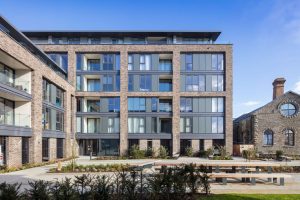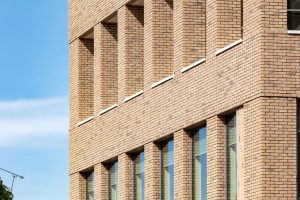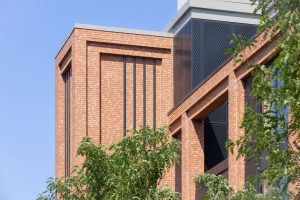With the four-year anniversary of the Grenfell Tower fire taking place in June, Paul Richards, Managing Director of Aquarian Cladding Systems, a specialist supplier of external brick and terracotta cladding systems, discusses what the industry is still learning from the tragedy.

Following the Grenfell Tower tragedy in 2017, fire safety has been at the forefront of the minds of everyone involved in the built environment, whether as an owner, lender, warranty provider, builder, consultant, supplier, or occupier, and it is only right that the fire performance of products and their impact on both new and existing buildings continues to be scrutinised.
Of course, the tragedy has had a huge impact on the construction industry globally but here in the UK cladding sector, it has been felt particularly acutely. We have especially seen a much greater sense of responsibility and caution when specifying, using, and supplying materials on new buildings of any scale.
We must however remind ourselves that we are learning what was wrong about a system and process of design, procurement and refurbishment of a building which started in 2012 and was completed in 2016.
Almost 10 years after the process began, we know that the use of combustible cladding was a contributory factor but the whole industry has had to have a good look at itself to reflect on a culture described by Dame Judith Hackitt as a ‘race to the bottom’ which drove those decisions.
More importantly, we are seeing evidence of a new culture influencing a new process, which will hopefully ensure it will never happen again.
Misleading information
The Grenfell Tower Inquiry continues to delve into practices of all sectors of the industry engaged in its refurbishment and Phase 2 of Module 2, completed in Spring 2021, put the spotlight on the testing, certification, and marketing of cladding products.
It identified a catalogue of misleading, ambiguous, and misrepresentative information provided by suppliers, as well as flaws in the testing and certification process and thankfully the industry is already addressing some of these issues before the official findings are announced in 2022.
For example, the Construction Products Association (CPA) has been consulting with industry on a proposal to adopt the Code for Construction Product information (CCPI), which will ensure that product information is presented by manufacturers using unambiguous and transparent language with greater data traceability.
This welcome step will ensure suppliers raise their game and stop sailing close to the wind with their clever use of misleading case studies, which in some cases suggested that because a particular material was right for a certain project, it is right for another when used with different materials through the wall.
As we now know, Grenfell wasn’t the only building that used a combination of cladding materials that had been mis-sold because they had never been tested together and proven safe to be used.
This culture has left us with the Cladding Scandal legacy and how to address the problem of properties clad in materials deemed unsafe. Many homeowners are living in properties rightly condemned; however, many aren’t, due to a lack of understanding by lenders and cladding consultants quick to condemn.
I responded to the Hackitt Review in 2018, stating that we should be careful of a knee-jerk reaction leading to a ban on all combustible cladding materials and a subsequent pariah-like impact on the value of the nation’s estate. It gives me no pleasure to say, “I told you so”.
‘Turned up to eleven’
It seems the decision-makers have “turned it up from nought to eleven” with neither option a sensible, well-informed method of risk assessment. It’s not healthy for the industry that there is a ‘binary’ view that all non-combustible materials are good, and all combustible materials are bad.
Some perfectly viable solutions are being missed because of the confusion perhaps created by those in a position to benefit commercially from scaremongering.
The biggest challenge is to provide, as a matter of urgency, a balanced and unambiguous method of demonstrating fire safety to the entire industry. This model is supported by Dame Judith Hackitt who has repeatedly called for an outcome-based solution, rather than prescriptive legislation.
Stakeholders can then confidently make informed decisions when specifying, building, warranting, and funding their projects.
Insisting that everything should be A1 or A2 is currently non-deliverable due to an over-reliance on a limited range of suppliers and the impact on our environment of using cement-based materials and unsustainable mineral resources such as sand and cement.
We also mustn’t lose sight of the fact that if non-combustible materials are designed and assembled incorrectly they too can be vulnerable in a fire.
Moving forward
We’ve noticed that as we try to innovate and bring new products to market, technical performance questions seem to be heavily focused on combustibility. Previously it was weather tightness, fatigue and thermal movement-related questions and we’re concerned that the importance of these issues should not be overlooked as statistically cladding systems are exposed to the elements, rather than fire, 99.9% of the time.
Requests for third-party evidence to prove the performance of materials have increased and companies like ours, who have invested historically in people and testing, to enable the provision of clear and robust technical support, are being rewarded with specifications as there are no long waiting periods for busy test houses to become available for testing retrospectively.
Changing a culture of ignorance and indifference won’t happen overnight but with changes to roles and responsibilities, as well as regulatory reform, I remain optimistic that our industry has the desire and ability to take collective responsibility for change. It must, as the alternative is unacceptable in the new Kindness Economy.
Working with architects, contractors, developers, and cladding contractors on many award-winning buildings across a wide range of sectors, Aquarian’s brick slip cladding systems include the A1-rated MechSlip and NaturAL-X, the Gebrik insulating Brick Cladding System and A1-rated Terreal Terracotta Rainscreen System. For more information or to discuss your project requirements please call 0808 223 9080, or email info@aquariancladding.co.uk




